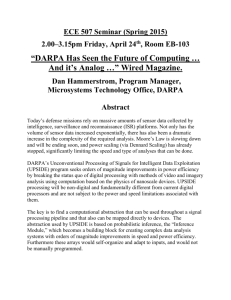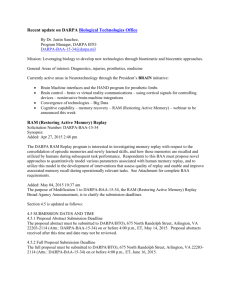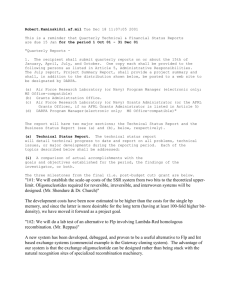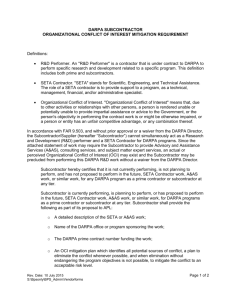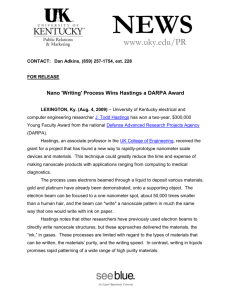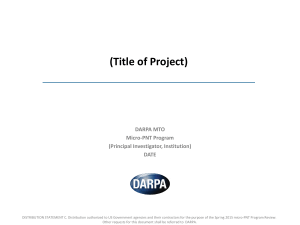Statement by Dr. Tony Tether Director
advertisement
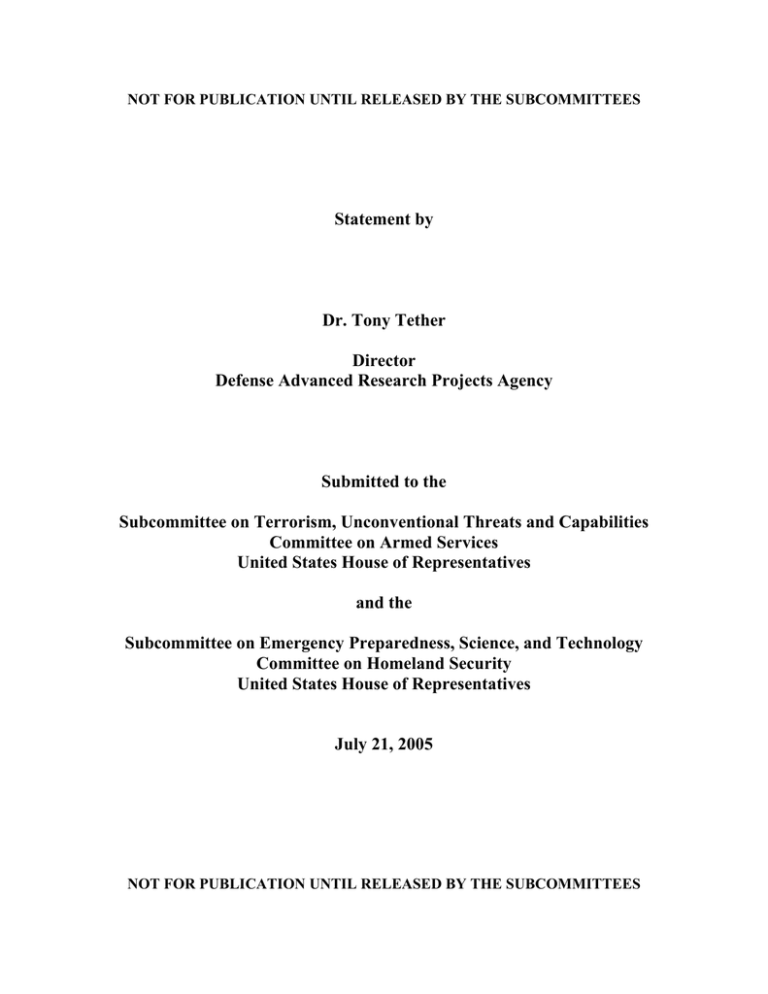
NOT FOR PUBLICATION UNTIL RELEASED BY THE SUBCOMMITTEES Statement by Dr. Tony Tether Director Defense Advanced Research Projects Agency Submitted to the Subcommittee on Terrorism, Unconventional Threats and Capabilities Committee on Armed Services United States House of Representatives and the Subcommittee on Emergency Preparedness, Science, and Technology Committee on Homeland Security United States House of Representatives July 21, 2005 NOT FOR PUBLICATION UNTIL RELEASED BY THE SUBCOMMITTEES Mr. Chairmen, Committee Members, and staff: I am Tony Tether, Director of the Defense Advanced Research Projects Agency (DARPA). I am pleased to appear before you today to talk about DARPA, DARPA’s role in the Department of Defense (DoD), and some of the technology we have developed – especially for chemical, biological, radiological and nuclear defense – that is applicable to civilian counter-terrorism. DARPA’s Role in the Department of Defense Some of you may not be familiar with DARPA, so let me begin by saying a few words about who we are and what we do. Established in 1958 in the aftermath of Sputnik, DARPA’s original mission was to prevent a technological surprise like Sputnik from ever happening again. Today, DARPA’s mission is still to prevent technological surprise, but also to create technological surprise for our adversaries. Stealth is one example where DARPA created technological surprise. DARPA conducts its mission by sponsoring revolutionary, high-payoff research that bridges the gap between fundamental discoveries and their military use. DARPA is a Defense Agency with a unique role within Department of Defense (DoD). DARPA is not tied to an operational mission. Instead, DARPA supplies technological options for the entire Department, and is designed to be the “technological engine” for transforming DoD. A large organization like DoD needs a place like DARPA whose only charter is radical innovation. DARPA looks beyond today’s known needs and requirements. DARPA’s approach is to imagine what capabilities a military commander might want in the future and accelerate those capabilities into being through technology demonstrations. These demonstrations not only provide options to commanders, but also change minds about what is technologically possible today. Let me tell you a little bit about how DARPA works. -1- Figure 1: Timelines and investments in science and technology. Figure 1 shows a science and technology (S&T) investment time-line that runs from “Near” to “Far,” indicative of how long it takes for an S&T investment to be incorporated into an acquisition program. On the “Near side” of this timeline we have a great deal of investment that represents most of the work of the Service S&T organizations. This is excellent S&T, and it is crucial because it continuously hones U.S. military capabilities; e.g., improving the efficiency of jet engines. However, it is typically focused on known systems and known problems. In contrast, out at the other end of the investment timeline – we call this the “Far side” – there is a much smaller investment that supports fundamental discoveries, where new science, new ideas, and radical new concepts typically first surface. People working on the Far side have ideas for entirely new types of technology, or revolutionary ways to put together capabilities from different Services. But the people on the Far side have a difficult, sometimes impossible time obtaining funding from those on the Near side because of the Near side’s focus on incremental improvements in current technologies. DARPA was created to bridge the gap between these two groups. DARPA’s mission, shown in Figure 2, is to find the promising ideas and people out on the Far side and accelerate those ideas to the Near side as quickly as possible, thus bringing entirely new core capabilities into the DoD. -2- Figure 2: DARPA’s role in science and technology. Hence, DARPA mines fundamental discoveries – the Far side – and accelerates their development and lowers their risks until they prove their promise and can be adopted by the Services. DARPA’s work is high-risk and high-payoff precisely because it bridges the gap between fundamental discoveries and their military use. DARPA’s strategy for accomplishing its mission is embodied in strategic thrusts, which change over time as the national security threats and technical opportunities facing our nation change. The nine strategic research thrusts that DARPA is emphasizing today are: • • • • • • • • • Detection, Precision ID, Tracking, and Destruction of Elusive Surface Targets Robust, Secure Self-Forming Tactical Networks Networked Manned and Unmanned Systems Urban Area Operations Detection, Characterization and Assessment of Underground Structures Assured Use of Space Cognitive Computing Bio-Revolution Core Technologies (i.e., materials, microsystems, information technology) These strategic thrusts are described in our Strategic Plan, which is available at www.darpa.mil/body/pdf/BridgingTheGap_Feb_05.pdf. In addition to these strategic thrusts, an important part of what DARPA is working on today supports the Global War on Terrorism by quickly developing technology to support military counter-terrorism operations in Iraq. -3- Many of the technologies that DARPA is developing have wider application outside the DoD, in civilian and commercial sectors. The Internet is the most famous example of DARPA technology that found its way into universal use. But along with the Web came cyberthreats such as Internet viruses and hacker attacks. In turn, many of the cyber security tools that are available commercially today began as DARPA programs. For example, network firewalls started in the 1990s with a DARPA project to protect the World Wide Web at the White House. DARPA and the Department of Homeland Security With this background in mind, let’s turn to DARPA’s work and how it relates to the Department of Homeland Security (DHS). Some of the technology that DARPA develops for the DoD will no doubt be useful to DHS and to other civilian departments for counter-terrorism. It already has been. DARPA has active ties with the Homeland Security’s Advanced Research Projects Agency (HSARPA), not only through the normal technical communities that we deal with, but also because many of the people in DHS Science and Technology Directorate, and HSARPA in particular, are former DARPA employees. So communications between us are easy and robust because we know and understand one another. Chemical/Biological/Radiological/Nuclear (CBRN) Defense Technologies Probably the richest area, now and in the future, for transitioning technology from DARPA to civilian agencies, including DHS, is Chemical, Biological, Radiological, and Nuclear defense. One of our strategic thrusts, Bio-Revolution, includes our biological warfare defense (BWD) program, which is clearly applicable to counter-terrorism. However, it is important to keep in mind that the BWD technologies DARPA is developing are oriented toward use in military operations, where the population and operational considerations are different than those of civilian operations. For example, a sensing system you might use to warn our troops in the field of chemical attack is not likely to be the same sort of system you would use in a city. Why? The false alarm (declaring an attack falsely) constraints are different, and civilians don’t have protective suits they can don in a matter of minutes. -4- Moreover, the populations are also quite different: the young, healthy men and women in the military who follow orders in a controlled environment are a very different group from the overall civilian population that spans young-to-old, infirm-to-healthy, and who live and work in a far less regulated setting. So while the technologies we are developing for military may not always directly map onto civilian use, but they may help lay the foundations for civilian systems. CBRN Sensors DARPA has been working on a range of sensors to detect CBRN threats. Recall the anthrax attacks of 2001. Today, much of the technology that’s being used in the nation’s Regional Post Offices to screen mail for anthrax and other biohazards was developed in a 1997-2000 DARPA project for creating novel devices for the specific diagnosis of biological warfare pathogens during military operations. Last year, millions of postal screening tests were conducted for anthrax using this device. DARPA’s TIGER (Triangulation Identification for Genetic Evaluation of Risk) program has developed a universal sensor that can detect any type of pathogen – even unknown and engineered ones – through an innovative method of measuring and weighing nucleic acid sequences. The TIGER system has been rigorously validated for use in biodefense applications, including surveillance for biological weapons agents in environmental samples and analysis of a broad range of biological samples for important human pathogens. DHS is now funding TIGER technology to use at the National Bioforensics Analysis Center. DHS plans to use TIGER as one of their instruments to analyze samples received from state and local first responders to see if they contain threat agents. TIGER provides a significant value to them because a single TIGER test can determine whether one of over 3,000 different organisms are present, whereas traditional testing methods can only detect one organism per test. DARPA’s Handheld Isothermal Silver Standard Sensor (HISSS) program is developing a handheld device to provide the soldier with laboratory-quality detection of the full biological threat spectrum (bacteria, viruses, and toxins). We have demonstrated that the false alarm rate of HISSS is significantly better than that of the current silver standard laboratory assays. -5- In fact, the Phase I results of program have persuaded HSARPA to incorporate the technology into the nation’s biosurveillance system and into the DHS Bioagent Autonomous Networked Detectors program. DARPA’s Semiconductor Ultraviolet Optical Sources (SUVOS) program has been developing wide band gap materials for optical emission in the ultraviolet region for bio-sensing and covert communications. Compared to conventional technologies, SUVOS will achieve a 50-fold reduction in power requirements and a 100-fold reduction in size and weight. HSARPA, DoD’s Joint Program Executive Office for Chem Bio Defense, and the Defense Threat Reduction Agency are now working together on HSARPA’s “Low Cost Biological Agent Detection System,” which is explicitly based on SUVOS technology from DARPA. In the future, I expect DARPA to sponsor more CBRN sensor technologies. For example, critical gaps exist in our capability to detect and identify chemical and biological agents concealed in packages delivered to military facilities. DARPA’s Advanced Portal Security program is developing technologies to rapidly search, detect and identify chemical and biological agents carried by individuals, or hidden inside envelopes in the mail or in other small containers like briefcases, backpacks, and boxes. Also, DARPA has some exploratory studies underway to assess standoff nuclear detection technologies and methods, another area of great interest for both military and civilian purposes. But to date, we have not come up with any robust solutions. CBRN Protection and Remediation DARPA is developing technologies to protect buildings and the people in them from chemical or biological attack. And, should such an attack take place, DARPA also has made investments in technology to remediate those buildings and restore them to service. The Immune Building program will make military buildings (such as barracks, office buildings, and command and control centers) far less attractive targets for chemical or biological attack by modifying the building’s heating, ventilation and air conditioning system to greatly reduce the effectiveness of any such attack. The program has three goals: to protect the people; to restore the building to full function as quickly as possible after the attack; and to preserve forensic evidence. -6- DHS is very interested in what we are doing in the Immune Building program and is following it closely. In particular, DHS, EPA, and the Joint Program Executive Office for Chem Bio Defense of DoD are co-funding the development and testing of a self-contained, portable chlorine dioxide generation system that can be rapidly deployed to decontaminate buildings following biological attack.1 Full-scale system tests will be conducted at several testbeds around the country to determine the efficacy of the decontamination, and fine-tune operational details. Turning to radiological dispersal devices (RDD) – so called “dirty bombs” – the threat from an RDD is not only that the radiation will be immediately toxic, but that a large area will be contaminated and unusable due to the risks of long-term exposure to radiation. DARPA has joined together with DHS under a Memorandum of Agreement to develop a system of technologies to detect, decontaminate, and perform a controlled clean-up of radioactively contaminated buildings and military bases located downwind from a RDD. Medical Countermeasures/Therapeutics A major element of DARPA’s ongoing work in BWD is the search for improved therapies against biological warfare agents our warfighters may encounter. This includes developing extremely broad spectrum therapies and rapid “bug-to-drug” technologies so we can quickly identify a pathogen and rapidly produce a therapy to address the threat. DARPA coordinates its BWD work with numerous organizations outside DoD, including the National Institutes of Health (NIH), HSARPA, and the Environmental Protection Agency. For example, every six months the DARPA Pathogen Countermeasures (PC) program is fully briefed to National Institutes of Allergy and Infectious Diseases (NIAID) leadership and NIAID program managers attend PC principal investigator meetings. DARPA managers meet with NIH leadership as needed, including with the Director of NIAID. 1 Although chlorine dioxide was used to decontaminate the Hart Senate Office building and the postal facilities at Brentwood (Washington, DC) and Hamilton Township (NJ), each of these operations required the construction of a "chemical plant" onsite to generate the decontaminant. -7- More broadly, from October 2004 through January 2005, DARPA hosted a series of meetings to inform government organizations both inside and outside the DoD on DARPA’s investments in chemical and biological defense research, and to promote awareness of potential upcoming product transitions. At least fifteen non-DoD organizations were at these meetings, including the DHS, NIH, the Food and Drug Administration (FDA), and the Environmental Protection Agency; we plan to continue them on a regular basis. In fact, a solid partnership is developing between DARPA and the FDA. Center and office directors at FDA have been briefed on DARPA’s work, and FDA personnel are now helping DARPA better understand regulatory issues and have provided input regarding quality and safety issues. FDA’s regulatory authority also means that they have a unique overview of all therapeutics “in the pipeline”-- information which is of great value to DARPA. Let me give you some examples: Improved Assays: • Cell based sensor arrays: DARPA developed a cell-based sensor array, sometimes called the “canary in a coal mine chip,” because it uses living cells to tell us whether biological threats are present. This technology was transitioned to the biodefense program at NIAID/NIH for environmental detection. • Anthrax detection assay: With support from DARPA, Army scientists have developed a highly specific phage-based assay to identify anthrax. The assay is currently being transitioned to the Centers for Disease Control and Prevention for inclusion in the nationwide Laboratory Response Network. Immune Boosters To help protect the warfighter from biological warfare threats, DARPA has been working on therapies that (i) broadly boost the human immune response to attacks, and (ii) make vaccines more effective (i.e., adjuvants): • Immune activation technology: Following initial funding by DARPA, NIH has funded a biodefense partnership to develop molecules that activate the immune system. • CpG for use as vaccine adjuvants: Following initial funding by DARPA, which enabled proof of concept for use of microbial DNA (i.e., CpG) to enhance the immune response, NIH has provided follow-on funding to develop new vaccine adjuvants for biodefense. CpG is now in clinical trials for use with the anthrax vaccine; it may be able to reduce the number of shots required for a complete course from six to two. -8- Laboratory Transition • In the late 1990s, DARPA established an animal testing facility at the University of New Mexico. Over 600 biodefense related medical countermeasures from across the country have been tested through this facility, and it was recently transitioned to the NIH. Other DARPA Technologies with Potential Counter-Terrorism Applications DARPA has developed a very small, long-endurance (for its size) aerial surveillance vehicle called WASP. The Coast Guard is interested in evaluating the WASP for port, ship, and coastal security. Improved machine language translation technologies would obviously be useful for terrorism risk assessments and, perhaps, even to first responders. DARPA continues to push significant improvements in the machine translation of natural languages. Our handheld, one-way speech translation device was used in Operations Enduring Freedom and Iraqi Freedom. The performance of machine translation technology on Arabic news feeds has vastly improved from essentially garbled output to nearly edit-worthy text, often understandable down to the level of individual sentences. This work points the way to unprecedented capabilities for exploiting huge volumes of speech and text in multiple languages. The goal of our Counter Improvised Explosives Laboratories (CIEL) program is to develop the infrastructure and methodology for novel chemo-sensors that will identify rooms where improvised explosives are being made with a high degree of specificity and reliability. This includes the explosive triacetone triperoxide (TATP), which was carried by the “shoe bomber” and possibly used in the recent attacks in London. CIEL will also develop the infrastructure and tools needed for safely handling improvised explosives so they can be disposed of more easily. All in all, as DARPA pursues its mission for the Department of Defense, our counterparts in civilian agencies like DHS are seizing the opportunities that arise to use these technologies in civilian counter-terrorism work. I would be pleased to answer your questions. -9-
